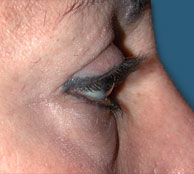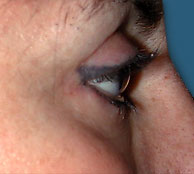|
Appearance: Excess fat that accumulates below the eyes, making them puffy: creating the “bags under the eyes” effect; upper lids that droop; eyes that are partially closed interfering with vision.
Surgery: Eliminates the excess skin, muscle and fat which are around the eyes removing the bags, droopiness and puffiness.
Length of the operation: For both the upper lids and the lower lids the procedure lasts approximately 45 minutes.
Anaesthesia: Eyelid surgery is usually performed under general anaesthetic. Depending on the operation, the surgeon might decide to use a local anaesthetic with sedation.
 |
 |
| Before |
After |
Description:
Upper Eyelid: The surgeon makes an incision along the fold of the upper eyelid and trims the sagging skin and muscle. Once the skin is separated, the surgeon can reach the excess fat to remove it. The incisions are then closed with either a Micropore tape/ intra-dermatome patch or with very fine sutures.
Lower eyelids: The surgeon performs an incision just below the lashes along the lower eyelids. The skin is separated from the underlying fatty tissue and muscle, so as to reach the fat deposits and remove them. The excess skin is trimmed and the outer part of the eyelids is lifted.
The surgeon can also perform a trans-conjunctivae blepharoplasty. In this procedure the eyelids can not be stretched or lifted.
Post-Operative: The eyelids may feel tight and sore with some bruising and swelling. For the first 6 to 8 hours cold compresses are placed on the eyes as this reduces swelling and bruising. There is a 24 hour hospital stay. The scars in the lower eyelids are scarcely visible, whilst the ones on the upper eyelids can be seen. The stitches are removed three days to one week after surgery.
Observations: The patient must have a full medical check up with an ophthalmologist before the operation so as to verify that there is no risk of glaucoma or dry eyes (lack of sufficient tears) and that the patient’s vision presents no danger.
Risks: Bruising, infection, conjunctivitis, keratitis.
OBSERVATION: The ultra-pulsar CO2 laser helps reduce swelling and bruising.
|